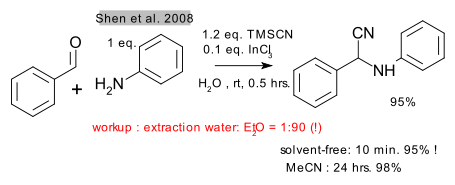Water is the medium
15 September 2008 - Really?
In 2007 Donna Blackmond co-authored a critical article on the use of water as reaction solvent in organocatalysis (DOI). Generally hailed as a contribution to green chemistry, after all what can be more environmentally friendly than water, Blackmond argues that organic reactions carried out in water generally require a lot of organic solvent during work up just to isolate the organic product (extraction). Alternatives such as stripping require a lot of energy. The water residue in any case is contaminated by organics and cannot just be discharged to a waste-water treatment plant. Although the criticism was targeted specifically at organocatalysis it is also relevant for a lot of research conducted in water-mediated organic reactions in general. This research is available today in great abundance and it would be interesting to examine if the researchers have taken Blackmonds points to heart. Be prepared to be 50% disappointed.
The reports listed below are all recent, all carry the phrase "in water" somewhere in the title and all advocate the use of water as environmentally friendly. This does not imply homogeneous systems and should also not be confused with an on water reaction.
The workup procedure in a reported water-borne Hiyama coupling by Chen et al. (DOI) involves a non-quantified amount of organic hexane or ethyl acetate.

On the upside though the water-phase including the palladium can be recycled at least 4 times!.
Marqués-López et al (DOI) report on a Strecker reaction in water without any catalyst that does require ethyl acetate extraction.

Shen et al. (DOI) also present a Strecker reaction in water (published just days after the one above) this time catalysed by Indium(III) chloride:

The method also requires extraction (this time with a lot of diethyl ether) but luckily a solvent free reaction is thrown in to save the day.
Next up Teimouri et al. (DOI) in a Knoevenagel condensation / cycloaddition multicomponent reaction and no complaints here because the ultimate reaction product (a 1-amino furan) simply precipitates from the water medium:

except for one by Marqués-López, none of the reports listed above actually cite Blackmond when they could and should have. In that respect the Blackmond message has not yet sunk in.
